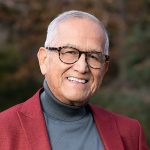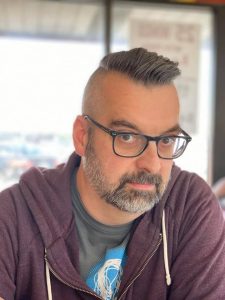
Rob Slaven – Courtesy of Indy Ghost Light Photography. Used with permission.
Within the past year, I began to notice a watermark for Indy Ghost Light Photography on production photographs theatres were increasingly sending me to accompany reviews I was writing. Since there is such a small cadre of photographers in the market who shoot performing arts events, especially theatre, my curiosity was piqued, so I started to dig around to find out who the photographer was behind a brand that clearly reflected a high quality. Having managed a community theatre and ballet company previously and as the current managing director of Magic Thread Cabaret, I am acutely aware of the necessity of utilizing publicity photos to properly market one’s show. Then, of course, is the cost, which can sometimes strain budgets, especially smaller theatres that have to stretch every dollar. The notion that there was someone in the community providing such a service for free made me eager to discover what the motivation was behind such altruism.
Eventually, I found out the benefactor’s name was Rob Slaven, and after further investigating, I discovered he shot production photos for theatres, large and small, on a pro bono basis. Slaven, however, does welcome donations to cover his expenses. Who is this person, I asked myself, and what’s his angle? Why the generosity?
Soon, Slaven and I sat down at Starbucks on Mass Ave, where he shared his MO. As it turned out, to my great consternation, our recorded interview was somehow corrupted and made incomprehensible, so Slaven, once again, kindly answered the same questions I had posed before, but this time, via email. Below is a transcript of that communication.
Tell me about your background? Where are you from? Education? Day job, etc.
I was born in Frankfort, Indiana and went to Purdue for a BS in Computer Science. By day, I work in IT for a large insurance company.
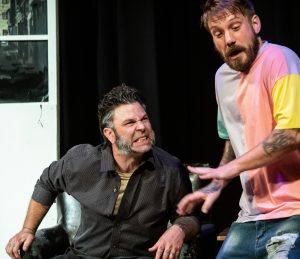
IndyFringe 2021 – Courtesy of Indy Ghost Light Photography, Used with permission.
What is your background in photography?
I took a film photography class in high school, mostly puttered around looking at flowers, etc. As an adult, I spent quite a bit of time chasing birds around the forest and trying to do nature photography. It wasn’t until stumbling into the theatre that I really did anything remotely serious with it.
How did you begin shooting local theatre productions?
I shot a few shows here or there, but I didn’t really get serious about it until my wife, Claire, was in a show at Footlite Musicals in 2019. She arranged with her director for me to shoot photos at rehearsals. As the show progressed, I just kept showing up with my camera until opening night. Seeing the incredible amount of work that she put into on the show with nobody to document the process was part of the reason I’ve become fairly fanatical about the theatre and shining a light on the immense amount of time and talent that goes into local productions.
How are you able to do it pro bono?
Like most of the local theatre community, I have a day job which supports my photographic activities.
What satisfaction do you derive?
Sources of satisfaction are abundant. I love seeing people use my photos because I hope it’s a signal that I’ve captured something that represents them well enough that they want to use it in their public-facing persona. I’m hopeful too that my work somehow makes the arts community more visible outside the theatre circle in the city. This is difficult to prove or quantify accurately, of course, but at the least I can say I’ve done everything I can to shine a light on the arts.
Name some of the theatres whose productions you shoot.
In terms of frequency, they include: Footlite Musicals, Southbank Theatre Company, American Lives Theatre, Catalyst Repertory, Phoenix Theatre, Mud Creek Players, OnyxFest BardFest ,Center Stage Community Theatre Buck Creek Players. Basile Westfield Playhouse, Attic Theatre. Carmel Community Players, CYT Indy, District Theatre, Freetown Village, and Belfry Theatre. As far as high Schools: Arsenal Tech, Franklin Central, Herron, Lutheran, University High and Pike.
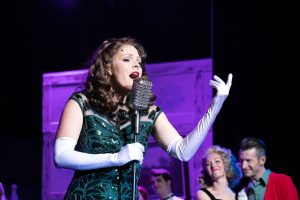
Holiday Inn 2021 – Courtesy of Indy Ghost Light Photography, Used with permission.
Are there special challenges to shooting live performance?
Standard photographic practices are centered on the photographer having control of the circumstances: lighting, backdrops, even the angle of the model’s chin. In live performance, all the control is elsewhere, and you have to adapt to what the venue and the circumstances provide to you. For this reason, I consider myself less of a photographer and more of a hunter. To me, the real thrill of this sort of work is in the hunt and the uncertainty of picking apart a two-hour performance to find the key, provocative moments that capture the essence of the work without having interfered with it in any way. Posing or “freezing” a scene leads to changes in the actors that you can clearly tell in the finished shot.
Do you shoot video too?
I do, but it’s a relatively new offering for me. I’m still working on the nuances and technicalities of this very different artform.
What are your criteria for choosing productions?
Initially, I spent a lot of time begging my way into any production that would let me in the door. More recently, I’ve started to receive more than enough requests to keep me busy without the prerequisite begging and I accept any show I have time for and that is within a reasonable driving distance.
Describe your schedule.
In a typical week I’ll have 5-10 photo events of some kind on my calendar. The typical split is 70 percent rehearsals or live shows and 30 percent staged promotional photos, headshots, or other ancillary services that theatre groups require.
What feedback have you received regarding your photos?
The theatre community has been incredibly kind and supportive. My wife jokes that we can’t walk down the street without someone stopping us to say how much they appreciate what I’m doing.
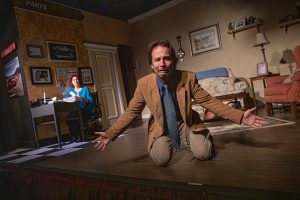
Epilogue Players 2022 – Courtesy of Indy Ghost Light Photography, Used with permission.022-
How do you manage to schedule the shoots you do?
Until a few months ago, I simply cold-called my way into every show I saw advertised, attempting to get my foot in the door. Now, however, enough acts request coverage through my website that I’m more than busy simply fulfilling those requests.
Do you feel your contribution to the performing arts is important?
I hope so. If nothing else, I think it does a lot to make performers feel properly “seen” and helps them communicate the shows they work on more effectively to their audiences. I’ve also had many requests to use my photos for professional portfolios, from lighting designers to actors, so it’s my hope that in some small way, I can help build those professional careers as well.
What photographer’s work do you admire?
Honestly, I almost never look at other photographers’ work, except in idle scrolling through Instagram.
Do you prefer shooting musicals or plays?
I don’t have a real preference, but they are incredibly different photographically.
Musicals are thrilling and frenetic, especially when they offer a large cast, because of the sheer number of angles and situations to be captured. Even for a large cast, I try to make sure everybody who appears on stage has at least one photo that makes them look like the star of the show. Doing that for a large cast is a delightful hunt under variable lighting conditions and with constant movement.
To the contrary, plays are methodical, scientific endeavors to photograph. Tracking the evolving storyline and relationships between characters and predicting when and where things will line up visually is a marvelous puzzle to be solved. There are often only two or three key visual moments during a play and predicting them and being in the right place at the right time are exciting things to discover.
What is your overall impression of Indy’s art scene?
Indy is an absurdly talented city, and it is my deepest lifetime regret that I didn’t get properly plugged into it 40 years ago. There are so many people in this city who dedicate such time and energy to creating art that it’s a huge shame that every seat in every theatre isn’t filled every night. Beyond the sheer talent of everyone who lifts a hammer or lifts a voice for the arts, I am proud of the hard topics the arts scene confronts so willingly and so well.
Most laudable of all, I think, is the manner in which all this is done. In a strict sense, all the production shops are competitors for ticket sales. Yet, on a daily basis, I see signs of cooperation and support between them as props and set pieces are shared, technical assistance is given, and schedules adjusted so one actor can participate in shows for multiple companies. The world has something to learn from the way in which artists cooperate competitively.
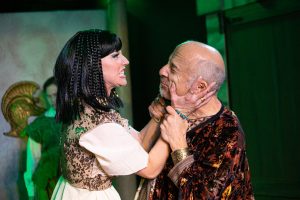
Bardfest 2021 – Courtesy of Indy Ghost Light Photography, Used with permission.
Why should the public support the performing arts?
Americans spend four hours a day watching television, but I think it’s underappreciated just how much more engaging live performance is. Personally, I’ve never seen a television show that made me feel as much as I do from even an average stage production. Whether the intent is to be funny, provocative, or inspiring, live humans on a stage are 10 times more effective. Not to mention, when the television show’s over, you turn it off. When the stage productions are over, you can often shake the actor’s hand or attend a talkback about the show. Opportunities for real engagement exist that just don’t for screen-based entertainment.
Even more importantly, community theatre programs, such as Footlite, give anyone an opportunity, not only to observe, but to actively participate in productions. If you can swing a hammer, tear a ticket, or even just talk to people, your local theatre would love to have you. You can be a part of the art.
What are your long-term goals as a photographer?
In an absolutely perfect world, of course, I would hope to create a community-funded organization that would allow me to dedicate all my waking hours to documenting and lifting up the arts community. As it stands, almost all my free time is consumed just getting photos and videos out to social media and to the production companies. This leaves little time for the other myriad things that could be done to further bolster the effort of making the arts more visible.
Realistically, I simply hope to build a body of work the city can be proud of. So much beauty is created in our community, that to have several years of it cataloged in one place and available freely and openly would be a treasure. On some level, I hope my work democratizes photography, so quality work is not solely available to those with huge budgets. One producer told me the last quote he received for a photographer was “more than his entire budget,” so he simply went without. That statement echoes through my brain every time someone asks about my pricing and that’s why my pricing remains where it is. I never want anyone’s work to go uncelebrated because of their budget.
For information about Rob Slaven’s photography services, visit indyghost.com, email slavenrm@gmail.com of call 317-753-1351.





